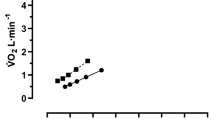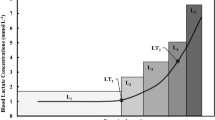Abstract
Recent research has resulted in a number of recommended changes in how fitness professionals should prescribe target workloads and calculate the energy cost of exercise. The principal changes are in the use of oxygen consumption reserve (V̇O2R) as an alternative to percentage of maximal oxygen consumption (V̇O2max) for prescribing exercise intensity, the use of net V̇O2 rather than gross V̇O2 for the calculation of caloric expenditure during exercise, and a modification of the American College of Sports Medicine (ACSM) equation for calculating the oxygen cost of leg cycle ergometry. The V̇O2R method of prescribing exercise workloads is similar to the heart rate reserve (HRR) method of prescribing target heart rates, i.e. the target workload is established at a given percentage of the difference between maximal and resting V̇O2. Several recent studies have shown that there is a discrepancy between the exercise intensity at given percentages of HRR and V̇O2max, but that HRR and V̇O2R yield equivalent exercise intensities. The use of V̇O2R in exercise prescription provides more accurate target workloads, especially for individuals with a low fitness level. Net V̇O2 during exercise is that amount above resting V̇O2 due to the exercise itself. A recent recommendation is to employ net V̇O2 in the calculation of the caloric expenditure during exercise, so as not to overestimate potential bodyweight loss. Several recent studies of leg cycling ergometry have yielded equations for the estimation of V̇O2 that include a term for unloaded cycling, i.e. the oxygen cost of moving the legs against zero resistance. The equations from these studies provide more accurate estimations of cycling V̇O2 than the existing ACSM equation, and a new standardised equation has been developed and adopted by the ACSM. The new equation is especially useful for improving the accuracy of V̇O2 estimates during low intensity leg cycle ergometry. The ACSM equation for bench stepping has also been modified to include a term for resting metabolism.


Similar content being viewed by others
References
Karvonen MJ, Kentala E, Mustala O. The effects of training on heart rate: a longitudinal study. Ann Med Exp Biol Fenn 1957; 35: 307–15
American College of Sports Medicine. ACSM’s guidelines for exercise testing and prescription. 5th ed. Baltimore (MD): Williams and Wilkins, 1995
Belman MJ, Gaesser GA. Exercise training below and above the lactate threshold in the elderly. Med Sci Sports Exerc 1991; 23: 562–8
Panton LB, Graves JE, Pollock ML, et al. Relative heart rate, heart rate reserve, and V̇O2 during exercise in the elderly. J Gerontol 1996; 51 A: M165–71
Swain DP, Leutholtz BC. Heart rate reserve is equivalent to %V̇O2 reserve, not to %V̇O2max. Med Sci Sports Exerc 1997; 29410–4
Swain DP, Leutholtz BC, King ME, et al. Relationship of % heart rate reserve and % V̇O2, reserve in treadmill exercise. Med Sci Sports Exerc 1998; 30: 318–21
Down RJ, Haennel RG. Percent heart rate reserve is not equivalent to percent maximal oxygen uptake [abstract]. Can J Appl Physiol 1997; 22 Suppl.: 13P
Davis JA, Convertino VA. A comparison of heart rate methods for predicting endurance training intensity. Med Sci Sports 1975; 7: 295–8
American College of Sports Medicine. The recommended quantity and quality of exercise for developing and maintaining cardiorespiratory and muscular fitness, and flexibility in healthy adults. Med Sci Sports Exerc 1998; 30: 975–91
American College of Sports Medicine. ACSM’s guidelines for exercise testing and prescription. 6th ed. Baltimore (MD): Lippincott Williams and Wilkins, 2000
Lang PB, Latin RW, Berg KE, et al. The accuracy of the ACSM cycle ergometry equation. Med Sci Sports Exerc 1992; 24: 272–6
Latin RW, Berg KE. The accuracy of the ACSM and a new cycle ergometry equation for young women. Med Sci Sports Exerc 1994; 26: 642–6
Londeree BR, Moffitt-Gerstenberger J, Padfield JA, et al. Oxygen consumption of cycle ergometry is nonlinearly related to work rate and pedal rate. Med Sci Sports Exerc 1997; 29: 775–80
Bevegard S, Freyschuss U, Strandell T. Circulatory adaptation to arm and leg exercise in supine and sitting position. J Appl Physiol 1966; 21: 37–46
Stenberg J, Astrand P-O, Ekblom B, et al. Hemodynamic response to work with different muscle groups, sitting and supine. J Appl Physiol 1967; 22: 61–70
Franklin BA. Exercise testing, training and arm ergometry. Sports Med 1985; 2: 100–19
Nagle FJ, Balke B, Naughton JP. Gradational step tests for assessing work capacity. J Appl Physiol 1965; 20: 745–8
Author information
Authors and Affiliations
Corresponding author
Rights and permissions
About this article
Cite this article
Swain, D.P. Energy Cost Calculations for Exercise Prescription. Sports Med 30, 17–22 (2000). https://doi.org/10.2165/00007256-200030010-00002
Published:
Issue Date:
DOI: https://doi.org/10.2165/00007256-200030010-00002




